File Too Large for Destination: How to Copy/Transfer Files Larger than 4GB to FAT32
FAT32 has a 4GB file size limit, making it impossible to transfer larger files. To overcome this, you need to change the file system on your USB flash drive or SD card to either exFAT or NTFS, which support larger file sizes. This can be done by formatting the drive with the new file system, or by converting the existing FAT32 to NTFS or exFAT without formatting, allowing you to transfer files bigger than 4GB.
PAGE CONTENT:
- Method 1. Reformat in File Explorer
- Method 2. Reformat in Disk Management
- Method 3. Change File System in Command Prompt
- Method 4. Convert File System in Qiling Partition Master
Why Can't Copy, Move or Transfer File Over 4GB to FAT32
You're trying to transfer large files (over 4GB) to a FAT32 formatted USB drive, which is causing the 'file is too large' error. The issue is that FAT32 has a 4GB file size limit. To resolve this, you can try formatting the USB drive to a file system that supports larger file sizes, such as NTFS. Alternatively, you can split the large files into smaller chunks using software like 7-Zip or HJSplit, and then transfer the chunks to the USB drive. Would you like me to elaborate on either of these solutions?
To troubleshoot issues with large file transfers between a USB drive and computer, it's essential to understand the FAT32 file system and its size limitations in Windows operating systems, including Windows 11, 10, 8, and 7.
What's FAT32?
File systems are a way to organize storage on devices like hard drives, SSDs, and USB sticks, among others. FAT32 is a popular file system used on various devices such as smartphones, tablets, digital cameras, and game consoles, and is also cross-compatible with operating systems like Windows, macOS, and Linux.
Also read: FAT32 vs NTFS
What's the maximum file size for FAT32?
4GB is the maximum size for individual files on a FAT32 drive, and the partition itself must be less than 8 TB.
Due to the FAT32 file size limit, it's not possible to manage files larger than 4GB, resulting in an error message when trying to copy, move, save, or transfer such files, including the message "The file is too large for the destination file system".
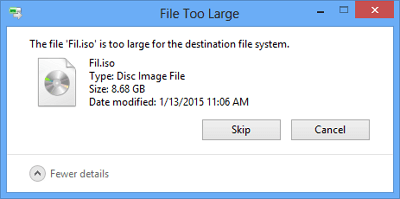
How to Transfer Files Larger than 4GB to FAT32 with or Without Formatting
The FAT32 file size limit needs to be exceeded to save large files, which can be achieved by changing the file system to NTFS, a Windows-compatible alternative. This conversion is relatively straightforward, with four methods available.
Formatting a disk in Windows Explorer or Disk Management will completely erase data, so it's essential to back up important files beforehand. Alternatively, you can use commands or third-party partition manager software like Qiling, which allow for a simple conversion without data loss.
Method 1. Reformat FAT32 in Windows File Explorer
Formatting a disk allows you to change the file system on a device, such as switching from FAT32 to NTFS to transfer larger files. In Windows 10/8/7, Windows File Explorer is a convenient option to format a disk, as it's built-in and doesn't require a download.
Note: Back up data before formatting FAT32 to NTFS
Step 1. Press Windows + E keys to bring up the Windows Explorer.
Step 2. Right-click on the connected USB drive or SD card and choose Format.
Step 3. From the File system drop-down list, choose NTFS, and click Start.
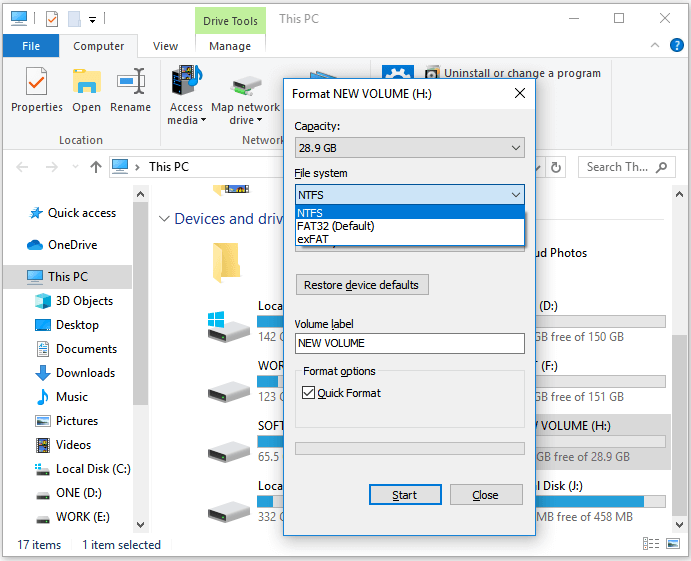
Method 2. Reformat FAT32 in Windows Disk Management
Windows Disk Management is a default program that allows you to format a FAT32 USB drive or SD card to NTFS, resolving issues with copying large files. It also enables you to format a RAW drive to a recognized file system by Windows, making it a useful tool for managing and formatting external storage devices.
Note: Back up data before formatting FAT32 to NTFS
Step 1. Navigate to This PC/My Computer > Manage > Disk Management.
Step 2. Right-click on the connected USB drive or SD card and choose Format.
Step 3. Choose NTFS as the target file system and click OK.
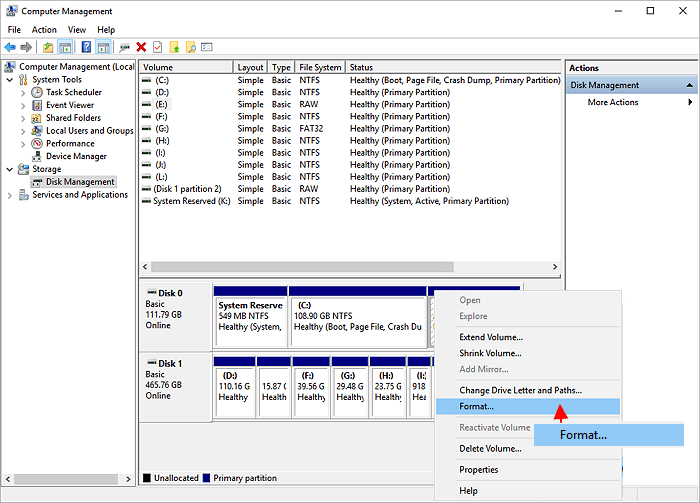
Method 3. Change FAT32 to NTFS in Windows Command Prompt Without Formatting
While the Windows command prompt method for fixing the "file too large for USB" issue is available, it's not recommended for computer novices due to its complexity and potential for data loss. Instead, a third-party easy solution can be used, which is a more user-friendly alternative.
Step 1. Press Windows + R keys to bring up the Run box, type cmd and hit Enter.
Step 2. On the Windows Command Prompt windows, type the command convert [drive letter]: /fs: [file system] and hit Enter.
For Example: convert G: /fs: ntfs.
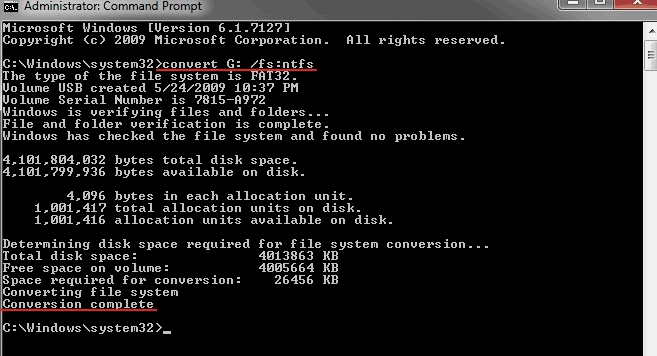
Method 4. Convert FAT32 to NTFS in Qiling Partition Master Without Formatting
Formatting a USB drive or SD card from FAT32 to NTFS can be done using Windows Disk Management or File Explorer, but this process will delete all existing data on the drive. However, for those who want to preserve their data, the command "convert X: /fs: ntfs" can be used, although this option may not be user-friendly for average computer users.
To address the limitations of previous methods for converting FAT32 to NTFS, which either resulted in data loss or were too risky, Qiling Partition Master offers a reliable solution. This free partition software can convert a FAT32 drive to NTFS without formatting, making it a safer and more convenient option. The conversion process is straightforward and requires only a few clicks, making it a simple and efficient way to achieve the desired file system change.
Step 1. Install and launch Qiling Partition Master on your computer.
Step 2. To format a FAT32 partition or convert a storage device to NTFS, select the partition or device, click on it, and choose the "Format" option. This will erase all data on the selected partition or device. If you're converting a storage device like an SD card or USB flash drive to NTFS, first insert it into your PC, then follow the same steps.
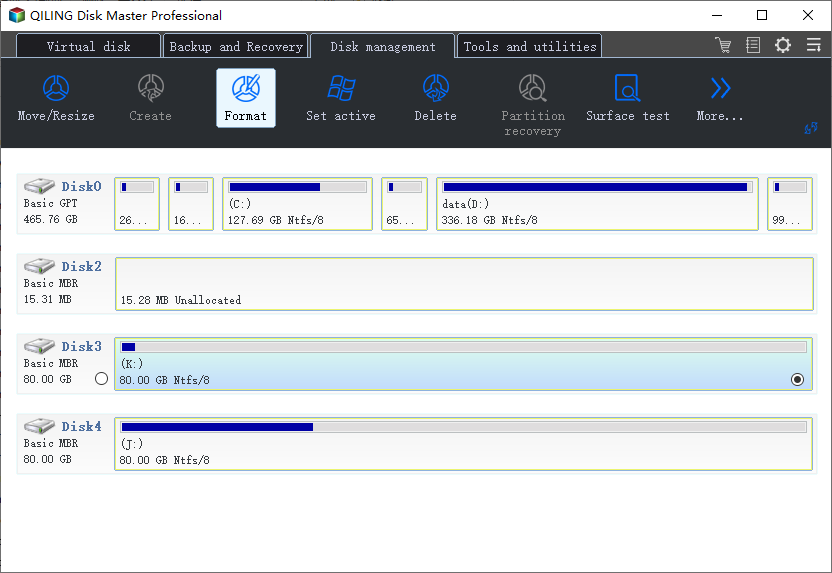
Step 3. In the next window, enter the Partition label, choose the NTFS file system, and set the cluster size according to your needs, then click "Proceed".
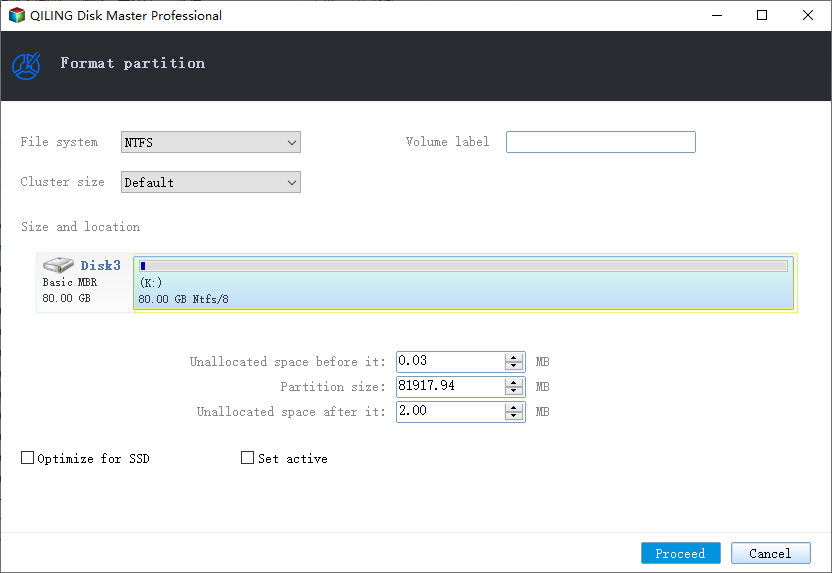
Qiling Partition Master is a versatile disk management tool that can help you format an SD card to NTFS or other file systems quickly and effectively. It also offers many other useful features, including resizing or moving partitions, merging partitions, converting between GPT and MBR, migrating the operating system, copying partitions, and more. Overall, it's worth downloading to regularly manage and optimize your computer's hard drive performance.
Conclusion
The debate between NTFS and FAT32 has sparked interest among users, with each format having its own advantages and disadvantages. While FAT32 is widely supported and easy to use, NTFS offers more features and is more secure.
This tutorial article provides two methods for converting FAT32 to NTFS, as well as three manual formatting methods for formatting a device from FAT32 to NTFS. If you choose to format, remember to back up data from the target device to another location first.
If you format the device without a backup, be sure to use a reliable file recovery software like Deep Data Recovery to help recover your lost files.
Related Articles
- How Do I Upgrade Gaming PC? [Beginners Guide]
- How Do I Fix Windows 10 BSOD: Blue Screen of Death Error? Here Is The Guide
- 7 Ways on How to Expand or Extend Partition in Windows 7/8/10 without Data Loss
- 2022 Magic Wester Digital (WD) Partition Manager Software Free Download
- Change GPT Disk to MBR Disk Without Formatting
- The Local Device Name Is Already in Use